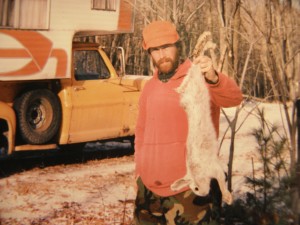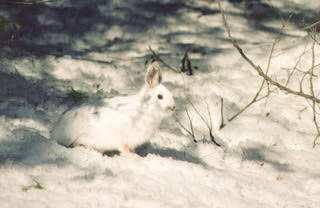The Vanishing Snowshoe Hare
By Glen Wunderlich
As part of Michigan’s recent license restructuring, the need to expand small game hunting opportunities was identified, and the DNR has made an investment to increase habitat work specifically benefiting squirrel, rabbit and snowshoe hare.
Hats off to volunteers with Michigan United Conservation Clubs and local Department of Natural Resources staff members who recently gave “hare cuts” on public land in the Grayling Forest Management Unit, as part of an effort to improve wildlife habitat for our declining snowshoe hare population.
The DNR has identified snowshoe hares as a featured species, an animal that is highly valued but is limited by habitat. Although habitat is just one of a number of different factors that affect survival, the lack of preferred habitat is the primary cause of wildlife declines worldwide.
The white fur gives snowshoe hares great camouflage when snow is on the ground. If there is little or no snow cover during the winter months, having white fur against a brown background can lead to increased detection by predators.
“Snowshoe hares are a type of rabbit here in the northern areas of Michigan, and a lot of folks have great memories hunting them,” said DNR wildlife biologist Brian Piccolo. “Unfortunately, snowshoe hare populations have steadily declined over the past few decades, and research suggests that this decline is due partially to shorter winters and less snow cover due to climate change.”
Climate change, huh? After reviewing the National Oceanic and Atmospheric Administration records over the past several decades, there is no hard evidence that suggests the number of days with snow on the ground has been declining anywhere in Michigan. Checking back to the beginning of climate records in the 1800s and early 1900s, evidence indicates that the number of days with snow on the ground has increased substantially.
I decided to probe the root cause of the disappearing bunnies a bit more and contacted avid outdoorsman, Bob Dalley, longtime property owner in northern Michigan’s Lower Peninsula. When asked about the once-thriving snowshoe hare population in his cedar habitat, he said he hadn’t seen one in over 15 years. He went on to explain that even cottontail rabbits have vanished more recently. Bob’s convinced that the primary reason is a burgeoning coyote population.
Before anyone begins to blame hunting pressure, it is interesting to note that the number of small game hunters in Michigan has declined about 75 percent since the mid-1950s and is currently at a record low.
However, the past few years show a remarkable increase in the number of coyotes being pursued by hunters and a commensurate amount being killed. In the Upper Peninsula, coyote harvest numbers are up some 37 percent, while the northern Lower Peninsula shows a 49-percent increase.
With coyote season closing April 15th, there’s still time to make a dent in their numbers. Michigan is the only state in the Midwest region of the nation that has a closed season on coyotes – and maybe, just maybe – that has a bearing on not only our small game populations, but our declining whitetail numbers, as well.






